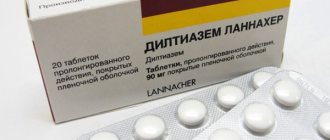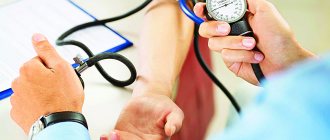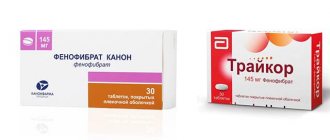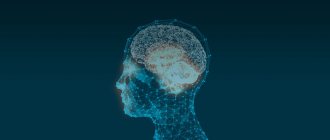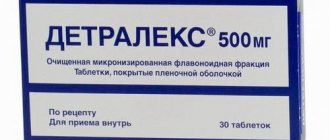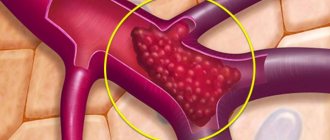Vascular pathologies are represented by a large group of diseases. According to statistical estimates, it is these disorders that more often become the direct cause of death of patients (for example, a stroke or heart attack as such leads to death, but the provocateur is stenosis or blockage of a vessel supplying cardiac or cerebral structures).
Angioprotectors are drugs aimed at correcting blood properties, strengthening vascular walls, increasing their elasticity and tissue regeneration.
There are many groups of these drugs and even more specific names. The mechanisms of influence are different, and therefore the effect is always different.
It is permissible to combine several pharmaceutical types of drugs to achieve a greater therapeutic result. However, it will not be possible to work out the scheme on your own. Rather, a person will achieve the opposite effect and aggravate the process.
The need to use medications in this broad group is determined by the course of pathologies of the cardiovascular system; it is also permissible to use medications for preventive purposes.
It is absolutely necessary to take it in the postoperative period. There are many questions, the answer can only be given by a specialist in vascular surgery or cardiology (often a whole council of doctors is required).
Mechanism of action
Angioprotectors are medications whose essence is to correct blood microcirculation and regenerate the vascular wall. The mechanism of their influence on arteries and veins includes three stages:
- anesthesia;
- relief of inflammation at all stages of the pathological process;
- bradykinin blockade: suppression of vascular endothelial pastiness, prevention of rupture of interendothelial gaps preceding atherosclerotic changes.
Angioprotectors and microcirculation correctors slow down the synthesis of hyaluronidase and prostaglandins. This process has not been studied in detail, since there are many drugs that are combined in this group, and their effect on the elements of the bloodstream is different.
The main properties exhibited by angioprotectors:
- increased antispasmodic activity, expansion of the lumen of blood vessels, improvement of microcirculation;
- correction of the rheological properties of blood with the prevention of thrombosis;
- reducing capillary fragility;
- normalization of metabolism in smooth muscles;
- balancing vascular tone, capillary wall permeability with simultaneous activation of the processes of diffusion, filtration, reabsorption, relief of edema, stagnation phenomena;
- prevention of oxidative stress.
Angioprotectors and microcirculation correctors
Angioprotectors (from the Greek angeion - vessel and protector - protector) and microcirculation correctors increase blood flow in the microvasculature (small vessels, capillaries), improve blood fluidity, reduce the fragility and fragility of capillaries. Improving blood supply leads to the activation of metabolic processes in the walls of blood vessels, as a result of which their swelling, congestion and inflammation are reduced.
The mechanisms of action of drugs in this group are different, and, as a rule, they have a multifaceted effect, without having high selectivity for certain receptors or substrates in the body. This is what determines the large selection of such drugs, since different degrees of interaction with different receptors determine the individual characteristics of each drug. Not being specific means for normalizing cerebral circulation. Some drugs in this group - xanthinol nicotinate, pentoxifylline, betahistine - are also very effective for vascular disorders in the brain. Angioprotectors and microcirculation correctors are widely used for various rheumatic and atherosclerotic lesions, disorders of blood vessel tone, venous diseases with congestion and inflammatory phenomena (including varicose veins), and so on.
The concept of the role of free radical oxidation in the pathogenesis of many diseases, which has emerged in recent years, has provided a theoretical basis for the use of antioxidants as angioprotectors. Damage to body cells by free radicals (so-called oxidative stress), which are constantly formed in the body in metabolic reactions and energy production or enter it from the outside, is one of the causes of such serious diseases as radiation sickness, atherosclerosis, myocardial infarction, stroke and diabetes , as well as oncological, bronchopulmonary and neurodegenerative diseases. The emergence and progression of these diseases is facilitated by unfavorable environmental factors, and in some cases, genetic abnormalities.
As a result of 40 years of observations, it was found that damage caused by free radicals in the cells of the human body accumulates with age. However, it remained unknown whether the aging process is caused by these disorders or whether such disorders only become more likely as old age approaches. But already in 1994, scientists proved that the life expectancy of fruit flies, which were made resistant to this kind of violations using genetic engineering, increases by 30 percent. This was the first direct confirmation that free radical-induced cellular changes are in fact the cause of aging and, accordingly, free radicals are a critical factor in the aging process.
Our body has sufficient protective forces in the form of a multi-stage system of free radical neutralizers. These are so-called antioxidants - chemical agents that bind ubiquitous free radicals. They come to our aid by providing additional electrons that stabilize free radicals and prevent damage to the body. Different antioxidants work in different ways. Some work in the cytoplasm of cells, others in the nucleus, others in cell membranes, and others in blood plasma or in particles of lipoprotein complexes. Antioxidants also differ in their effectiveness in neutralizing free radicals and reactive oxygen species.
The human body's natural antioxidants include enzymes such as superoxide dismutase, peroxidase, and small molecules produced by our cells such as glutathione. Antioxidants are also vitamins and minerals produced by the body or obtained in food - vitamins E and C, beta-carotene, which is a precursor to vitamin A, selenium, zinc, copper, manganese; some amino acids.
Considering the important role of free radicals in damage to cardiac cells, the use of antioxidants as a means of pathogenetic therapy for coronary heart disease and its complications is justified and promising. The newest of them is the drug Mexicor®, developed by Russian scientists.
Mexicor® has pronounced antioxidant and antihypoxic properties. It helps to normalize lipid metabolism disorders in atherosclerosis, reducing the content of total cholesterol and cholesterol in low-density lipoproteins by 25%–35% and increasing the content in high-density lipoproteins, which remove excess cholesterol from cells, and also has a hypotriglyceridemic effect of the drug. In patients with stable angina pectoris, Mexicor® increases exercise tolerance by 20%, while the number of angina attacks and the number of nitroglycerin tablets consumed by patients are reduced.
An important additional effect is the ability of the drug to enhance the effect of nitrates. This means that the combined use of Mexicor® and nitroglycerin, which significantly improves coronary blood flow, has an advantage over the use of nitroglycerin preparations as monotherapy.
Indications for use
The group of angioprotectors corrects many pathological conditions, which are based on impaired permeability of the vascular wall, changes in the rheological properties of blood, and an imbalance of metabolic processes.
Therefore, each subgroup of angioprotectors has its own indications for use, which can be found by carefully reading the instructions included with each individual drug. But there is also a generalized list of indications for treatment with drugs of this group:
- atherosclerotic disease, including obliterating endarteritis of the lower extremities due to metabolic disorders;
- diabetic angiopathy, threatening amputation without timely initiation of therapy;
- IHD: angina pectoris, cardialgia of various etiologies, heart failure, arterial hypertension, acute conditions caused by myocardial ischemia, cardiosclerosis, cardiomyopathies;
- cerebrovascular syndrome: from encephalopathy to stroke;
- hemorrhoidal disease;
- thrombosis, thrombophlebitis due to changes in blood viscosity;
- vascular calcification, loss of elasticity;
- vasculitis;
- aneurysms;
- disruption of regional blood flow in any zone;
- varicose veins, venous insufficiency;
- retinopathy;
- nephropathy.
It is not difficult to understand what angioprotectors are: the drugs of the group are united by the result of their action - the ability to reduce the load on vessels of any localization, restoring the structure of the walls of arteries and veins, elasticity, strength, eliminate destruction, stimulating regeneration processes in the body, and balance the functioning of the blood clotting system.
The group is large, but there are not many main representatives of each subgroup. The characteristics of drugs are based on their action, which is correlated with the therapeutic potential of the drugs. A list of the most common angioprotectors is given below.
Antiplatelet agents
{banner_banstat2}
The basis of the effect of using drugs in this group is the ability to thin the blood and prevent the formation of blood clots, which reduces the load on blood vessels and prevents the development of emergency conditions (primary or after surgery).
Attention:
The drugs must be used with extreme caution; in some combinations they can cause bleeding.
They are absolutely not suitable for use without medical supervision.
Heparin
{banner_banstat3}
Quite an old drug with a pronounced effect, but its duration hardly reaches several hours.
Therefore, the medication is especially actively used in inpatient settings for patients in a complex condition, with stroke, heart attack, thrombosis.
It has a lot of side effects and is used in the form of injections. Not suitable for course purposes due to risks - this is a first aid remedy.
There are also more modern and safer analogues with a long lasting effect. For example, Clexane or Fraxiparine.
Aspirin and analogues
Unlike Heparin, modern names of antiplatelet drugs based on acetylsalicylic acid are suitable for long-term use over many years.
The essence is the same blood thinning.
Among the effective analogues of simple Aspirin are Magnicor, Plavix, Plagril, Cardiomagnil and others. They are more effective, but also have different degrees of safety.
The question of prescribing a specific medication remains at the discretion of the specialist. It is necessary to take into account concomitant diseases and contraindications.
According to statistics, constant use of drugs from this subgroup helps reduce the risk of heart attack and stroke by almost 60%.
Classification of drugs
Advertising:
It is difficult to classify angioprotectors. There are several approaches to their gradation. The simplest one is in the form of release: tablets, suppositories, creams, gels, ointments for topical use. The second division is the method of application: external or for oral administration.
Angioprotectors can be divided into three large groups based on the origin of the drugs: herbal, semi-synthetic and synthetic.
There is a classification based on diseases that can be treated with tablet drugs:
- Antiplatelet agents, anticoagulants - drugs that correct blood viscosity, lyse blood clots in diseases of various origins that have a chronic course, make up the first group (Heparin, Aspirin, Cardiomagnyl).
- Thrombolytics are drugs with a similar mechanism of action, but for acute conditions: pulmonary embolism, heart attack, stroke - the second (Streptokinase, Urokinase).
- Drugs for normalizing microcirculation, correcting vascular lesions in diabetes mellitus, retinopathy, atherosclerosis (Pentoxifylline and its analogues, prostaglandins) are the third group of drugs.
- Phlebotonics, which eliminate damage to the venous bed, restore the function of venous valves (Detralex) are the fourth group of angioprotective agents.
- Vasodilators that reduce the load on the walls of blood vessels by expanding their lumen are the fifth group of drugs (Tivomax).
- Metabolic drugs that improve metabolism and blood circulation in different areas of the human body are the sixth group of drugs with angioprotective properties (Actovegin).
- Drugs that are used to treat retinal vascular pathology (Emoxipine) are a separate seventh group of drugs.
Angioprotectors can be divided into mono-drugs and multi-component drugs. In any case, the purpose of prescribing drugs in this group is to eliminate vascular disorders of various types.
Intraocular injections
Intravitreal injections are the injection of a drug directly into the eye cavity (into the vitreous body). Such injections are performed for hemorrhages (partial hemophthalmia), wet form of macular degeneration, retinal edema, the appearance of newly formed vessels and other serious eye diseases.
In our clinic, intravitreal injections are performed by ophthalmologists with extensive experience in complex intraocular injections in sterile procedure rooms, in compliance with appropriate medical protocols. Such therapy for retinal pathologies, using effective medications, allows one to preserve visual function and also achieve a significant improvement in visual acuity.
Lucentis
The active component of the drug is ranibizumab, a substance that suppresses excessive angiogenesis (the formation of pathological blood vessels), which is characteristic of age-related macular degeneration. In addition, it helps relieve macular edema, normalizing the thickness of the retina. The drug quickly penetrates completely into the layers of the retina, reducing the size of the lesion, preventing possible hemorrhages and further progression of the growth of newly formed vessels with a pathological wall. More about Lucentis >>>
Eilea
The active substance of Eylea is aflibercept. Its action is aimed at inhibiting the progression of age-related macular degeneration (wet form). In addition, it has the ability to act effectively and safely in reducing visual acuity in the case of diabetic macular edema and edema caused by retinal vein occlusion.
The innovative drug Eylea has a long-lasting effect, so injections can be performed less frequently than with Lucentis, which is much more convenient for patients. More about Eylea >>>
Ozurdex
It is used in cases of macular edema caused by occlusion of the retinal veins. The drug is produced in the form of a thin implant in the form of a rod, which is inserted into the vitreous body. The implant contains the potent steroid dexamethasone, which begins to be released inside the vitreous in small portions. This innovative method of dosed delivery of a medication to the affected area significantly increases the duration of action of the hormone, which can last up to six months. Read more about Ozurdex >>>
Parabulbar and intravitreal injections are performed under sterile conditions
Preparations for normalizing microcirculation
This includes drugs that can influence the blood viscosity system and stimulate blood flow with vasodilator properties, as well as substances that relieve inflammation with automatic expansion of the lumen of the capillaries - prostaglandins. Trental is considered the most popular.
Pentoxifylline and drug analogues
The essence of the angioprotective action of Pentoxifylline is the regeneration of vessels damaged by atherosclerosis or inflammation, improvement of blood viscosity, microcirculation due to the indirect expansion of the lumen of the capillaries. There are tablets (251 rubles) or ampoules (45 rubles).
- Trental (Flexital). This is a complete analogue of Pentoxifylline, prescribed for encephalopathies of various etiologies, ischemic stroke, vascular problems, in ENT practice. Price – 150 rubles.
- Vazonite. A long-acting drug thins the blood, balances microcirculation, but is able to correct coronary blood flow and relieve tissue hypoxia. Price – 379 rubles.
- Latrain. A medicine with the widest spectrum of action, applicable for all types of trophic disorders. The angioprotector is prescribed as part of complex therapy for ulcerative tissue lesions, gangrene, frostbite, varicose veins, and is used for diabetic polyneuropathy, angiopathy, and in the recovery period of ischemic stroke. Price – 215 rubles.
- Agapurin. A high-quality drug that is prescribed to patients with rheumatism, ENT pathologies, bronchial asthma, for the prevention of blood clots in the lower extremities. Allowed for pregnant women. Cost – 187 rubles.
Prostaglandins
Advertising:
All drugs relieve inflammation, resolve blood clots, lower blood pressure, and stimulate vascular tone through smooth muscles:
- Enzaprost-F – 4,500 rubles;
- Misoprostol – 1,100 rubles;
- Alprostan – 6,000 rubles.
Retinal angiopathy - treatment with drops
Angiopathy is a pathology of retinal vessels caused by various negative factors (hypertension, diabetes mellitus). In order to eliminate its manifestations, an ophthalmologist in the early stages of the disease or as part of complex therapy prescribes certain eye drops to patients.
The goal of such therapy is to activate the metabolic processes of the organ of vision, stimulate the speed of local blood flow, and improve the process of tissue nutrition. Eye drops are becoming one of the components of therapy for symptomatic treatment. Eye drops are becoming one of the components of therapy for symptomatic treatment. Read below what medications are prescribed.
Eye drops are convenient, but not very effective.
Taufon
The main component of the solution is taurine. Apply the solution 1-2 drops in each eye three times a day for a long time. The drug is produced in bottles of 5 and 10 ml.
Indications for use of Taufon:
- Moderate retinal angiopathy.
- Corneal injuries.
- Early stage cataract.
- Dystrophic changes in the retina and cornea.
- Open angle glaucoma.
Expected effect:
- Stabilization of cell membranes.
- Acceleration of the regeneration process of traumatic corneal injuries.
- Activation of metabolic and energy processes.
- Normalization of IOP.
Emoxipin
This is a synthetically produced antioxidant, a solution of which is instilled daily, three times a day, 1-2 drops in each eye. Treatment lasts several days or for a long time - as prescribed by a doctor. The drug is not prescribed to pregnant women, as well as to persons with allergies to the components of the solution.
Indications for use:
- Diabetic retinal angiopathy.
- Cerebral circulation disorders.
- Various origins of hemorrhage in the eye.
- Corneal burns.
- Complicated myopathy and glaucoma.
Expected effect:
- Resorption of small hemorrhages on the retina.
- Protects the mesh shell from bright light.
- Strengthening the walls of blood vessels, reducing their permeability.
- Stimulation of local blood flow.
Emoxipine and Taufon (taurine) are the most popular eye drops for retinal diseases
Quinax*
Expected effect:
- Stimulation of metabolic processes in tissues.
- Activation of antioxidants.
- Increased lens transparency.
*At the moment, the drug is no longer available.
Aisotin
Able to increase and restore visual acuity in case of eye diseases. Available in 10 ml bottles. It is instilled three times a day, 1-2 drops, for 2-3 months.
Indications for use:
- Diabetic angiopathy.
- Restoring visual function after eye surgery.
- Conjunctivitis.
- Eye burns.
- Redness of the eyes.
- Glaucoma.
It is better to discuss the use of any medications with your attending ophthalmologist.
Emoxy optic
Substitute for Emoxipine at a lower cost.
- Indications for use:
- Eye burn.
- Bleeding in the eye.
- Progressive myopia.
- Inflammatory processes of the organ of vision.
Expected effect:
- Normalization of the permeability of vascular walls.
- Stimulation of local blood circulation.
- Resorption of hemorrhages in the eye.
- Elimination of the effects of oxidative stress.
- Increasing tissue resistance to hypoxia.
Phlebotonics
A group of angioprotectors that tone the valvular apparatus of the veins, improve venous blood flow, and relieve congestion. Used to treat hemorrhoids and varicose veins. By normalizing blood circulation in the corresponding area, inflammation is relieved, the vessels automatically dilate (pastiness due to exudation disappears), and elasticity is restored. The most common is Detralex.
- Detralex. An angioprotector that stimulates the tone of venous valves, improves the elasticity of vascular walls, has an effect when taken as a course, and does not affect the blood clotting system. Prescribed for vascular congestion in any area. Price – 640 rubles.
- Venarus. Structural analogue of Detralex of domestic production. Cost – 490 rubles.
- Phlebodia 600. Angioprotector with venotonic properties, restores the vascular wall, relieves inflammation, venous congestion, improves microcirculation. Price – 850 rubles.
- Vasocket. Vasoket tablets are based on flavonoids with angioprotective, restoring the structure of the vascular wall, and anti-inflammatory properties. Cost – 600 rubles.
- Antistax. Angioprotector, belongs to the group of herbal phlebotonics. Natural components provide a mild effect: relieves pastiness, stimulates local immunity, improves vascular permeability. Price – 580 rubles.
Means for increasing the lumen of arteries
The mechanism of action of this group of angioprotectors is based on the ability to expand the lumen of blood vessels, reducing the load on arteries and capillaries, thereby normalizing blood flow to a certain area. These are nitro group donors. There are two drugs on the pharmacological market: Tivomax, Tivortin.
The active ingredient of Tivomax is the amino acid arginine chloride. Refers to blood replacement solutions, available in bottles with a solution for infusion. The drug exhibits protective effects that are important in a critical condition of the body.
Prescribed for atherosclerosis, diabetic angiopathy, angina pectoris, CHF, hypertension. Price – 135 rubles through online pharmacies.
A structural analogue of Tivomax is Tivortin. Price – 214 rubles through online pharmacies.
Metabolic drugs
Angioprotectors, which are part of the group of metabolics, have a complex effect on the human body, including a positive effect on blood flow, the condition of blood vessels, metabolism, stimulate the utilization of glucose, increase the energy reserves of cells, and prevent ischemia and hypoxia. Prescribed for all forms of coronary artery disease, encephalopathies, vascular and metabolic disorders
. The most famous is Actovegin.
- Actovegin. The drug is an antioxidant, antihypoxant with a metabolic, neuroprotective, microcirculatory effect. Indicated for circulatory disorders, including peripheral, cognitive disorders, diabetic polyneuropathy. Price – 569 rubles.
- Glycine. Angioprotector with metabolic properties, has antidepressant and sedative effects. Price – 30 rubles.
- Inosine (Isoprinosine). An ATP precursor drug with antihypoxic, metabolic and antiarrhythmic effects. Increases the energy balance of the myocardium, improves coronary circulation, and is applicable for all types of coronary artery disease. Cost – 604 rubles.
Treatment regimens for retinal angiopathy
Drug therapy in the case of angiopathy and its vascular complications should be comprehensive. If necessary, treatment can be continued in courses. Before prescribing it, an ophthalmologist develops a specific, most effective regimen for using drugs. As a rule, these are the following appointments:
- Drug therapy aimed at activating blood circulation in the vessels of the eyes is necessary. This is a course treatment with Emoxipin, Vazonit, Mildronate, Arbiflex, Solcoseryl, Trenatal. They help activate local microcirculation processes. Another property of these drugs is improving the plasticity of red blood cells. This allows them to move faster through the small vessels of the eyes.
- Pentoxifylline and Curantil help prevent possible thrombus formation. Xanthiol nicotinate and nicotinic acid improve blood rheology.
- To reduce vascular permeability, ginkgo biloba and calcium dobesilate are prescribed.
- Actovegin injections are designed to provide better nutrition to the eye tissues. To improve metabolic processes in eye tissues, ATP and cocarboxylase are used.
- It is mandatory to take vitamin complexes to maintain eye health - Lutein-intensive, Anthocyan Forte. It is important to take ascorbic acid, which accelerates microcirculation processes in blood vessels and maintains visual acuity.
- For diabetic retinopathy, it is necessary to adhere to a special diet that can neutralize diabetes mellitus and improve blood flow in the retinal vessels. It is worth remembering that prohibited foods include any food rich in fast carbohydrates (baked sweets, sweet soda, etc.). The same applies to excessively high-calorie foods. Limiting salt is also important, because it helps normalize metabolism and improve recovery processes.
- Vigorous physical exercise, included in the daily routine to give energy to the muscular system, also improves the condition of the eye vessels.
- When treating angiopathy caused by hypertension, it is mandatory to lower blood pressure levels through medications and specially designed dietary adjustments. To do this, you should contact a cardiologist and nutritionist.
- It would not be superfluous to prescribe physiotherapeutic procedures. In the case of angiopathy, magnetic therapy courses and acupuncture can show good results.
- Another physiotherapeutic method is “Sidorenko Glasses”. This device combines the effects of pneumomassage, infrasound, phonophoresis, and color therapy. The powerful effect on the retina of such a complex makes it possible to achieve good results in a short time.
- Treatment also helps with massage courses on the cervical spine.
Drugs for the treatment of retinal vascular pathology
{banner_banstat9}
This is a separate group of special agents that improve the condition of the retinal vessels, normalizing its blood supply and oxygen supply:
- Emoxipine - normalizes the permeability of the vascular wall, demonstrates the properties of an antihypoxant, antioxidant, improves the rheological properties of blood (211 rubles);
- Etamzilate (Ditsinon) – an antihemorrhagic agent that improves microcirculation (37 rubles);
- Divaskan - reduces increased vascular permeability (1350 rubles).
Contraindications
Restrictions on use are also individual, as are the indications for prescribing drugs in this group. But angioprotectors are generally well tolerated, so some data can be generalized across subgroups of agents.
Anticoagulants are not prescribed if there is a predisposition to bleeding, including hereditary nature.
Vasodilators, metabolic drugs, phlebotonics are not recommended for individual intolerance or sensitization of the body.
Drugs to improve microcirculation are contraindicated in:
- pathologies of the cardiovascular system;
- rehabilitation after hemorrhagic stroke;
- risk of bleeding;
- aged over 60.
Indications
{banner_banstat9}
It is clear to say in which cases medications should not be used. Because the list of groups is large, the mechanisms are different. We need to proceed from this.
The average list of readings looks like this:
- Atherosclerosis. Including obliterating, affecting the lower extremities.
- Angiopathy of diabetic origin.
- Coronary heart disease, cardiac dysfunction, including against the background of poor nutrition in the coronary arteries.
- Cerebrovascular insufficiency. Trophic (nutrition) disorders of the brain.
- Hemorrhoids, varicose veins (predominant indications for the use of phlebotonics).
- Tendency to form blood clots as a result of impaired blood flow (it becomes thick).
- Increased fragility of blood vessels.
- High probability of aneurysm formation (objective indicators, especially if they are combined with complicated heredity).
Side effects
{banner_banstat10}
Negative consequences are also individual and depend on the type of drug. With a high degree of probability we can talk about the development of the following side effects:
- anemia;
- hives;
- asthma attack;
- anaphylaxis to Quincke's edema;
- migraine;
- nosebleeds;
- tinnitus;
- rhinorrhea;
- dyspepsia;
- symptoms of intoxication;
- blood impurities in urine.
Fatal complications are extremely rare and develop due to the negligence of a doctor or patient: stroke, acute heart or kidney failure.
Literature
- Dedov, I.I. State register of diabetes mellitus in the Russian Federation: status in 2014 and development prospects / I.I. Dedov, M.V. Shestakova, O.K. Vikulova // Diabetes mellitus. – 2015. – No. 18(3).
- Egorov, E.A. The use of angioprotectors in the treatment of diabetic angiopathy: focus on calcium besylate / E.A. Egorov, Zh.G. Oganezova // Russian Medical Journal. – 2015. – No. 4.
- International Diabetes Federation. IDF Diabetes Atlas, 7th ed. Brussels: International Diabetes Federation, 2015.
- Yau JWY, Rogers SL, Kawasaki R. et al. Meta-Analysis for Eye Disease (META-EYE) Study Group. Global prevalence and majority risk factors of diabetic retinopathy // Diabetes Care. 2012.
- American Diabetes Association. Standards of medical care in diabetes: 2008 // Diabetes Care. 2008.
